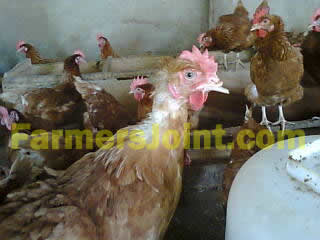Egg eating is a frustrating habit that can spread quickly among layers once it begins. Fortunately, there are proven steps farmers can take to prevent or stop this problem.
1. Reduce Stress and Overcrowding
a. Overcrowding increases stress, aggression, and egg pecking.
b. Provide at least 1.5–2 square feet of floor space per bird to keep them comfortable.
2. Feed Them Properly
a. Nutrient deficiencies, especially calcium, often trigger egg eating.
b. A laying hen needs about 4–4.5 g of calcium daily.
c. Provide calcium sources such as limestone, dicalcium phosphate, crushed/burnt oyster shells, snail shells, or egg shells in a separate feeder.
d. Ensure hens receive adequate Vitamin D, which aids calcium absorption.
e. Include bone meal in rations to supply both calcium and phosphorus for stronger shells.
f. Avoid underfeeding — each layer needs about 110–120 g of balanced feed daily.
Read: Feed Consumption Plan and Body Weight Target for Laying Hens
3. Provide Proper Nesting Boxes
a. Nest boxes should measure about 12 x 12 x 12 inches, be dark, quiet, and lined with soft bedding.
b. Too much light encourages pecking — keep nests dim or add curtains at the entrance.
c. Raise nest boxes 18–24 inches above the ground.
d. Provide 1 nest box for every 4–5 hens (e.g., 20 hens need 4–5 nest boxes; 100 hens need 20–25).
4. Collect Eggs Frequently
a. Do not leave eggs in the nest for too long.
b. Collect eggs multiple times a day to reduce temptation.
5. Use Fake Eggs
a. Place ceramic or rubber eggs in nests.
b. When hens peck them and find nothing, they gradually lose the habit of egg eating.
6. Identify and Isolate the Culprit
a. If you identify a hen eating eggs, isolate her for at least one week.
b. This helps break the habit and prevents others from copying her.
7. Manage Lighting in Nesting Areas
a. Keep nesting areas dimly lit.
b. Excessive light stresses hens and encourages egg pecking.
8. Cut Beak Tips
a. Hens use their sharp beak to break eggs. You can cut the pointed ends slightly to prevent this. This process is called beak trimming or debeaking. It has other advantages like preventing feed wastage, fighting, cannibalism and more. Read: Debeaking: What is It and Should you Debeak Your Birds?
Below is a debeaked hen. Top beak is made shorter than the bottom one

Final Thoughts on Preventing Egg Eating in Layers
Stopping chickens from eating their eggs requires good poultry management practices. Focus on:
a. Providing adequate space,
b. Feeding balanced rations with enough calcium and vitamins,
c. Setting up secure, dark nest boxes
d. Collecting eggs regularly.
e. Beak trimming
By following these steps, poultry farmers can effectively prevent or stop egg eating and maximize egg production.
Frequently Asked Questions (FAQ)
Why do chickens start eating their eggs?
Chickens eat eggs mostly due to stress, overcrowding, poor diet, or calcium deficiency. Sometimes it begins accidentally when a hen pecks a cracked egg and develops the habit.
What can I feed chickens to stop egg eating?
Provide feeds rich in calcium, such as crushed oyster shells, limestone, snail shells, or recycled eggshells. A balanced diet with enough protein and vitamins also helps prevent egg eating.
How many nest boxes do I need for 20 chickens?
You need about 4–5 nest boxes for 20 layers. The general rule is 1 nest box for every 4–5 hens.
Will fake eggs stop chickens from eating eggs?
Yes. Ceramic or rubber eggs trick hens into pecking without reward, helping them lose interest in breaking real eggs.
How do you collect eggs to prevent egg eating?
Collect eggs several times a day, especially in the morning, to reduce the chances of hens discovering and eating them.
Does trimming beaks stop chickens from eating eggs?
Beak trimming reduces egg cracking and pecking

Leave a Reply